 2008-050A October 12, 2008
2008-050A October 12, 2008
Pad 1, Site 5, Baikonur Cosmodrome, Republic of
Kazakhstan
April 8, 2009
151 km northeast of Dzhezkazgan, Republic of Kazakhstan
Soyuz-FG (serial number Щ15000-026),
Soyuz TMA (serial number 223)/17S 178 da 00 h 13 min 38 s (Lonchakov, Fincke)
11 da 20 h 35 min 37 s (Garriott)
Titan
ISS resident crew transport (17S), ISS-18 resident crew; visiting crew 15 (Generation II Astronaut, GTA) research program
Flight crew
LONCHAKOV, Yuri Valentinovich, 43, Russian Federation Air Force, RSA Soyuz TMA commander, ISS flight engineer 1, third mission Previous missions: STS-100 (2001), Soyuz TMA-1 (2002)
FINCKE, Edward Michael, 41, USAF, NASA Soyuz TMA flight engineer, NASA ISS commander, second mission Previous mission: Soyuz TMA-4/ISS-9 (2004)
GARRIOTT, Richard Allen, 46, civilian, American space flight participant ISS resident crew exchanges
CHAMITOFF, Gregory Errol, 45, NASA ISS flight engineer 2 (up STS-124, down STS-126)
MAGNUS, Sandra Hall, 44, NASA ISS flight engineer 2 (up STS-126, down STS-119), second mission Previous mission: STS-112 (2002)
WAKATA, Koichi, 45, JAXA (Japanese) ISS flight engineer 2 (up STS-119, down STS-127), third mission Previous missions: STS-72 (1996), STS-92 (2000)
Flight log
The 18th resident crew arrived at the docking port of Zarya on October 14, 2008, two days after leaving the Baikonur Cosmodrome. They assumed formal residency from the ISS-17 crew on October 22.
|

Former Skylab and Space Shuttle astronaut Owen Garriott and his son space flight participant Richard Garriott talk with reporters outside the Cosmonaut Hotel crew quarters, Baikonur Cosmodrome. Photo credit: NASA/Viktor Zelentsov.
|
In command of the Soyuz, but serving as flight engineer on the station was veteran cosmonaut Yuri Lonchakov. He had previously flown on two visiting missions to the station on Shuttle in (2001) and on the maiden flight of TMA (2002). The flight engineer on Soyuz and commander of the residency was veteran NASA astronaut Michael Fincke, who had previously logged 187 days aboard the station on ISS-8. Arriving with the ISS-18 crew was Richard Garriott, the latest
SFP and son of Skylab and Spacelab astronaut Owen Garriott. He would return with the outgoing ISS-17 cosmonauts in TMA-12 after a flight of 10 days on station.
The experiences of his father were mirrored in Garriott’s own program of research on the station 35 years later. The Generation II Astronaut (GTA) project featured nine experiments. There were two more under the ESA program and three under the U. S. medical program. The nine experiments featured research in life science, biotechnology, technical research, education, and humanities, as well as a range of public affairs and outreach programs. Six experiments were performed in the Russian segment, the other three in the U. S. segment. Garriott was assigned 33 hours of experiment time, supported by one of the Russian cosmonauts for photo-documentation. The memory of his father’s Skylab mission was also recalled with an updated Leonardo da Vinci figure used as the mission emblem as was the case with his father’s Skylab 3 emblem. Garriott’s return on TMA 12 completed a highly successful 12-day mission.
For the main crew, the Russian research program consisted of 46 experiments, only 5 of which were new investigations. The remainder were continuations of previous investigations. There were 6 experiments in human life research, 7 in geophysical research, and 3 in Earth research. A further 14 experiments were under the heading of space technology, with 6 technical research investigations, 2 contracted activities, and 2 on the study of cosmic rays. There were also 3 educational experiments and 3 more in space technology and material sciences. A total of 161 hours were allocated for Russian science across the mission.
Over in the U. S. segment, the research to be completed during this residency included 40 NASA-managed experiments in human research, exploration technology testing, biological and physical sciences, and education. In addition, there were 33 experiments planned by the European and Japanese space agencies.
During this expedition, three other crew members worked with the Russians. When the main crew arrived, Chamitoff was already aboard. He was replaced by Sandra Magnus on STS-126 in November 2008 and she in turn was replaced in March 2009 by Japanese astronaut Koichi Wakata on STS-119. The two Shuttle missions delivered further logistics to the station, with STS-126 being the second dedicated Utilization and Logistics Flight and STS-119 delivering the long-delayed final set of solar arrays and truss element S6. Both flights included several EVAs in support of the activities by Shuttle crew members.
ISS-18 crew members Fincke and Lonchakov conducted two EVAs totaling 10 hours 27 minutes from Pirs, wearing Orlan-M suits for the final time before the improved Orlan MK suits were introduced. The first EVA (December 23, 2008, 5 h 38 min) was designated Russian Segment EVA 21 and included the retrieval of experiment samples and deployment of a Langmuir probe to measure electrical and plasma fields close to the docked Soyuz spacecraft. Studies of electromagnetic energy were linked to the ongoing investigations into the problems with the pyrotechnical separation bolts on the Soyuz which had troubled TMA-10 and TMA-11. The EVA crew deployed two experiments on a special platform on the outside of the Zvezda module.
The second EVA (March 10, 2009: 4h 49 min), designated Russian Segment EVA 21A, was not part of the original mission planning, but when the pair had difficultly installing a ESA experiment on their first EVA, the second excursion was added instead of returning the hardware to Earth. This time, the EXPOSE-R biological exposure samples were installed and the two men took time to clear six straps from the docking area on Pirs to prevent hindrance with future docking operations. Other tasks included closing a loose insulation flap on Zvezda, removing an experiment cassette, and further photo-documentation.
This mission also featured the arrival at station of the latest variant of the venerable unmanned Progress resupply cargo craft, the M-01M (31P), on November 30. Launched on November 26, the longer-than-usual approach allowed ground controllers to fully evaluate the new systems on the vehicle before committing to ISS docking. Outwardly resembling the earlier versions, this upgraded variant included a state-of-the-art digital computer system and more compact avionics, saving 165.3751b (75 kg) dry mass over previous versions, with 15 fewer components. The upgraded equipment enabled automatic diagnostics between the telemetry and computer systems while also providing digital interfaces for the integration of all systems when docked with the ISS.
With the arrival of the TMA-14 crew (ISS-19) at the end of March, and completion of their science program, it was time once again to exchange the responsibility of command of the station; this was completed on April 2, formally ending the ISS-18 residency after 162 days. Arriving at the station with ISS-19 crew was Space Flight Participant Simonyi, on his historic second 10-day visit to the station. He returned with ISS-18 crew, who undocked in Soyuz TMA-13 on April 8, 2009 after 176 days on board the orbital complex. Their safe landing was achieved later that day near the town of Dzhezkazgan in Kazakhstan.
Milestones
262nd manned space flight 106th Russian manned space flight 99th manned Soyuz flight 13 th manned Soyuz TMA mission 17th ISS Soyuz mission (17S)
15th ISS Soyuz visiting mission 18th ISS resident crew
1 st flight of a son of a NASA astronaut (Richard Garriott/Owen Garriott) Chamitoff celebrates his 46th birthday (August 6)

Flight crew
FERGUSON, Christopher John, 47, USN, NASA commander, second mission Previous mission: STS-115 (2006)
BOE, Eric Allen, 44, USAF, NASA pilot
PETTIT, Donald Ray, 53, civilian, NASA mission specialist 1, second mission Previous mission: ISS E06/STS-113/TMA-1 (2002-2003)
BOWEN, Stephen George, 44, USN, NASA mission specialist 2 STEFANYSHYN-PIPER, Heidemarie Martha, 45 USN, NASA mission specialist 3, second mission Previous mission: STS-115 (2006)
KIMBROUGH, Robert Shane, 41, U. S. Army, NASA mission specialist 4 ISS resident expedition crew member transfers
MAGNUS, Sandra Hall, 44, civilian, NASA mission specialist 5 (up only)/ISS – 18 flight engineer, second mission Previous mission: STS-112 (2002)
CHAMITOFF, Gregory Errol, 45, civilian, NASA mission specialist 5 (down only)/ISS-18 flight engineer
Flight log
Dubbed a mission of home improvement and maintenance, this flight was packed with robotic arm operations, repairs, and servicing activities. Designed to deliver construction equipment intended to expand the living conditions in order to accommodate a permanent crew of six, the flight also featured another exchange
|

Post press conference crew photo. Don Pettit appears at photo center. Below him is Stefanyshyn-Piper. Clockwise from her position are Kimbrough, Bowen, Boe, Furguson, Fincke, Lonchakov, Magnus, and Chamitolf.
|
of NASA-ISS flight engineers via the Space Shuttle, as part of the resident crew of station prior to permanent six-person crewing.
In the original planning, Endeavour was intended to support the forthcoming Hubble Service Mission (STS-125) before flying on STS-126. Endeavour was rolled into the OPF on March 27, 2008 for processing. It was then relocated to the VAB on September 11, 2008, for stacking to the ET and SRB. On September 19 the STS-126 stack was relocated to Pad 39B to serve as an emergency rescue vehicle (if needed) for the STS-125 Hubble Service Mission 4, which was preparing to launch from Pad A. This was the first time since 2001 that a shuttle stack had sat on both launchpads at the Cape. When the Hubble mission was postponed into 2009 in late September due to problems with the telescope, all work on Endeavour to support the mission ended and focus shifted back to STS-126. When Discovery was rolled back to the VAB on October 20, Endeavour was moved across to the now vacant Pad 39A on October 23, 2008, the day after its Multi-Purpose Logistics Module (MPLM) payload arrived.
The launch into a night sky was flawlessly performed on November 14, 2008. A 5 h inspection of the vehicle’s heat shield was conducted by the crew using the RMS and OBSS, prior to docking with station. Analysis of the imagery and data on the ground revealed that a small piece of thermal blanket was loose on the aft portion of Endeavour. As with previous flights, Endeavour was inverted for documentation and analysis of the underside. Following further analysis of the data, it was determined that there would be no need for a further inspection, as the heat shield looked in good condition for entry.
Endeavour docked with the ISS on November 16 and this was followed a few hours later by Magnus exchanging places with Chamitolf on the resident crew. He had spent 167 days as member ISS-18. The following day, MPLM Leonardo was relocated by the ISS robotic arm to the nadir port on Harmony. On board Leonardo were 6.5 tons of equipment, including two large water-recycling racks, a new “kitchen”, a second toilet, two further sleeping stations, extra exercise equipment, and other supphes.
Mission specialists Stefanyshyn-Piper, Bowen, and Kimbrough completed a series of four EVAs during the mission, totaling 26 hours 41 minutes. Bowen logged the most time at 19 hours 56 minutes in three space walks. Piper logged 18 hours 34 minutes in her three space walks, while Kimbrough’s two EYAs logged 12 hours 52 minutes.
During the first EVA (November 18; 6 h 52 min), Piper and Bowen spent the majority of their time outside working on the SARJ, removing two of the joint’s Trundle Bearing Assemblies (TBAs). They also removed a depleted nitrogen tank from a storage platform on the station, returning it to the payload bay of Endeavour. Other tasks included moving a flex hose rotating coupler from the Shuttle across to the Station Storage Platform and removing insulation blankets from the Cameras Berthing Mechanism (CBM) on the Kibo laboratory.
Approximately halfway into this EVA, one of the grease guns that Piper was preparing to use at the SARJ released some of the Braycote grease into her Crew Lock Bag. This is the bag used by spacewalkers during their activities to retain spare tools and equipment. As she was cleaning the inside of the bag, it drifted away from her towards the aft and starboard of the station. It was soon out of reach, preventing her from retrieving it. Inside this bag were two grease guns, scrapers, several wipes and tethers, as well as several tool caddies. Piper and Bowen spent the remainder of their EVA time sharing a duplicate set of tools from the other Cew Lock Bag (CLB) they had with them.
During the second EVA (November 20; 6h 45 min) Piper and Kimbrough moved two Crew and Equipment Translation Aid (CETA) carts. They also lubricated the station’s RMS latches and an end effector snare (the capture device), then cleaned and replaced four TBAs. The next EVA (November 22, 6h 57 min) saw Piper and Bowen replace five more TBAs and clean and lubricate race rings on the station’s starboard SARJ.
On the final EVA (November 24, 6 h 7 min), Kimbrough and Bowen replaced the final TBA on the station’s starboard SARJ, lubricated the race rings on the port SARJ, moved a video camera on the Part 1 Truss, and installed two Global Positioning Satellite Antennas on the Japanese Experiment Module (JEM) Logistics Module. They also retracted the latch on the JEM Exposed Facility Berthing Mechanism and reinstalled the mechanical cover.
In addition to the EVAs conducted outside the station, the crew occupied themselves by working with the resident station crew to convert the orbital facility to support a six-person crew and completed a wide variety of other tasks. Latches on the Exposed Facility Berthing Mechanism on the Japanese Kibo Laboratory were also tested. This mechanism would be used to install the External Science Platform on the Kibo, which would be delivered in 2009.
The astronauts installed a new Water Recovery System, which was designed to treat waste water and then provide recycled water that was clean and safe enough to drink. Supplying any crew with fresh drinking water has always been one of the challenges facing long-duration mission planners, spacecraft designers, and medical staff. Short missions are more easily accommodated, but supporting a crew of six or more 24/7 for 365 days a year is a logistical challenge. Lessons learned from previous space station programs, applied and improved on the ISS, will lay the groundwork for long-duration flights away from Earth, to the Moon, Mars, and the asteroids.
The Urine Processor Assembly (UPA) shut down during initial test operations. The station and Shuttle crews, as well as ground controllers and engineers, investigated possible causes and cures over the next several days. It was determined that the motion of the centrifuge had caused physical interference with the UPA, which resulted in increased power draw and temperatures. The UPA was hand-mounted onto the Water Recovery System (WRS) rack after grommets were removed. Following this remedy, the UPA ran normally. On the 10th day of the mission, the NASA Management Team extended the mission’s docked duration by an extra day. This would allow additional time for further WRS troubleshooting if required.
On November 25, the crew were informed that the starboard SARJ had completed a 3 h 20 min test, during which it automatically tracked the Sun for the first time in over a year. In addition, the UPA had completed its second run without shutting down. The combined crew celebrated Thanksgiving aboard station and sent a greeting to American personnel who were serving abroad, away from home and family. The crews thanked members of the armed services for their commitment and dedication and wished them well.
With joint operations nearing completion, MPLM Leonardo was relocated back into the payload bay of Endeavour on November 26 for the return home. Undocking occurred on November 28 after joint operations totaling 11 days 16 hours 46 minutes with Chamitoff logging 179 days on the station. Endeavour’s pilot, Eric Boe, completed a standard fly-around of the station for photo-documentation. The next day, the crew conducted an inspection of the thermal
protection system with the RMS and OBSS. Following analysis of the images, the heat shield was cleared for entry and landing.
Towards the end of orbital operations on November 29, a small, 15.4351b (7 kg) USAF satellite was deployed. PICOSat was designed to test and evaluate space environment effects on new solar cell technology. Expected to remain in orbit for several months, it finally de-orbited on February 17, 2010.
Weather concerns at the Florida primary landing site forced two standoffs before finally diverting the landing to California. Endeavour landed on a temporary runway adjacent to the concrete Runway 22 at Edwards Air Force Base. The concrete asphalt runway was 12,000 ft (3657.6 m) long by 20 ft (6.09 m) wide, with a 1,000 ft (348 m) underrun and overrun capability for Shuttle load-bearing support. As this runway was 1,940 ft (3,000 m) shorter than the nominal runways, new braking and rollout techniques had to be employed for this landing, providing new and additional information on landing a Shuttle orbiter.
Milestones
263rd manned space flight 154th U. S. manned space flight 124th Shuttle mission 26th flight of Endeavour 27th Shuttle ISS mission 9th Endeavour ISS mission First dual-pad Shuttle preparation since 2001
First landing on a temporary runway at Dryden due to maintenance on main runways
Bowen was first USN submarine officer selected for NASA astronaut training, and the second submariner to fly in space (after Mike McCulley on STS-34 in 1989)

Flight crew
ARCHAMBAULT, Lee Joseph, 48, USAF, NASA commander, second mission Previous mission-. STS-117 (2007)
ANTONELLI, Dominic Anthony, 41, USN, NASA pilot ACABA, Joseph Michael, 41, civilian, NASA mission specialist 1 SWANSON, Steven Roy, 48, civilian, NASA mission specialist 2, second mission
Previous mission-. STS-117 (2007)
ARNOLD II, Richard Robert, 45, NASA mission specialist 3
PHILLIPS, John Lynch, 57, USN Reserve (Retd.), NASA mission specialist 4,
third mission
Previous missions-. STS-100 (2001), ISS-ll/TMA-6 (2005)
ISS resident crew members
WAKATA, Koichi, 45, civilian (Japanese), JAXA mission speciahst 5 (up only)/ISS flight engineer, third mission Previous missions-. STS-72 (1996), STS-92 (2000)
MAGNUS, Sandra Hall, 44, civilian, NASA mission specialist 5 (down only)/ ISS flight engineer, second mission Previous mission: STS-112 (2002)
Flight log
One of the challenges that a researcher of Shuttle missions has to overcome is the mission numbering system and sequence. For most of the program, the missions
|

View of completed solar array after delivery and deployment at the ISS.
|
did not fly in sequence of allocated numbers. This was especially true for the delayed STS-119, which flew after STS-126 but before STS-125!
The inclusion of four crew members whose surnames began with “A” saw the crew being termed the “A” team. Two of these (Acaba and Arnold) were former teachers turned astronauts, who were selected in 2004 to assist NASA to inspire young people to study mathematics and science and hopefully to go on to pursue engineering and aerospace careers.
This mission dehvered the fourth and final set of solar array wings, as well as the S6 truss, completing the structural backbone of the station and the main electrical power supply to the facility. With the installation of the final set of arrays, full power capacity could reach 120kW of electricity, doubling the available power for scientific experiments from 15kW to 30 kW and allowing the station’s permanent resident crew complement to increase from three to six.
Final preparation for the mission began with Discovery being taken into the OPF on June 14, 2008. Rollover to the VAB occurred on January 7, 2009, with transfer to Pad 39A a week later on January 14. The original launch date had been set for February 12, but this was postponed following an issue with the gaseous hydrogen flow control valves. These valves are part of the system that channels gaseous hydrogen from the main engines to the External Tank. The valves had to be replaced and the launch was reset for March 11.
On that date, however, the launch had to be postponed again for at least 24 hours, due to a hydrogen leak in the left-hand vent line between the Shuttle and the ET. Managers and engineers looked at potential repair options and the launch was rescheduled for no earlier than March 15. This meant the flight’s docked time at the station would be reduced by two days so that the Shuttle could depart prior to the arrival of the next resident crew on Soyuz TMA – 14.
The March 15 launch occurred on time and with no problems during ascent. During FD2 (March 16), the crew completed a close inspection of the orbiter’s wing leading edge panels using the RMS and OBSS. The crew installed the orbiter docking system “centerline” camera, tested the rendezvous equipment, and extended the docking ring on the top of the docking assembly. Prior to docking with the station on March 17, the orbiter completed the now familiar backflip maneuver for heat shield damage assessment. Experts in the field and the Damage Assessment Team in Mission Control Houston determined that the heat shield was healthy for reentry.
Discovery docked with the ISS on March 17, with Magnus and Wakata swapping roles and Soyuz seat liners later the same day. Magnus had spent 121 days as a member of the ISS-18 crew by the end of the mission, logging 129 days on board the station and a total of 134 days in space. Her replacement, Koichi Wakata, became the first representative of Japan to join a resident crew. The following day (March 18), the ITS S6 truss structure was relocated across to the station from Discovery’s payload bay ready for the series of EVAs to attach it permanently to the station.
There were three EVAs completed during this mission, totaling 19 hours 4 minutes, with three astronauts conducting two EVAs each. Swanson logged 12 hours 37 minutes, Acaba 12 hours 57 minutes, and Arnold 12 hours 34 minutes. On the first EVA (March 19, 6h 7 min), Swanson and Arnold bolted the S6 truss into place. They then connected the power and data cables that allowed station flight controls to command the segment into operation remotely.
For the second EVA (March 21, 6h 30min), Swanson teamed with Acaba. They prepared a work site for new batteries that were scheduled for delivery on STS-127. In addition, they installed a Global Positioning System antenna on the Pressurized Logistics Module attached to the Japanese Kibo laboratory. This would allow the Japanese automatic H-II Transfer Vehicle (HTV) to rendezvous with the station later in 2009. It also set the stage for future assembly tasks by station and Shuttle crews. A misaligned bracket proved too difficult to reposition during the installation of a cargo carrier attach system, so the two astronauts moved to other tasks, including image documentation of the station’s radiators.
The third and final EVA (March 23, 6h 27 min) saw Acaba and Arnold relocate one of the two CETA carts from one side of the Mobile Transporter to the other. Again, difficulty was encountered when they had trouble freeing a stuck mechanism. This would have enabled them to deploy a spare equipment platform, but the task had to be deferred to a future space walk. A similar task on another Payload Attach System was also deleted from the EVA by Mission Control. The astronauts did lubricate the end effecter capture system on the station’s RMS. This task had proven effective during the STS-126 mission, preventing the snare from
snagging and allowing it to return snugly into its groove inside the latching mechanism.
Inside the station, the crew replaced a failed unit on a system that converted urine to potable water. By March 24, 701b (8.38 gallons or 30.09 liters) of urine had been processed in the system, from which 151b (1.79 gallons or 0.39 liters) of reclaimed drinking water had been collected. Samples from the Water Recovery System were collected for analysis on Earth to determine if the purified water was suitable for the crew to drink before any was consumed on the station. Two loadmasters (Arnold and Phillips) were assigned the task of keeping track of the transfer of supplies and logistics across to the station and the unwanted gear, experiment results, and samples back into the orbiter.
On March 24, both the Shuttle and station crews (10 astronauts and cosmonauts) gathered in the Harmony Node on station to speak with U. S. President Barack Obama, Members of Congress and schoolchildren from the Washington, D. C. area. Discovery undocked later that day (the 10th day of the mission) after 7 days 22 hours 33 minutes of joint operations. As usual, the mission pilot (in this case, Antonelli) performed the undocking and fly-around maneuver around the station while the rest of the crew photographed the completed truss assembly, now with the final set of solar array wings fully deployed.
On March 26, Antonelli used the Shuttle RMS to hold the OBSS, enabling the lasers and cameras to scan the surface of the orbiter for any signs of damage to the thermal protection system. No such damage was found. The first landing opportunity was waived off due to gusty winds and clouds at the Shuttle Landing Facility at the Cape, but conditions improved enough to allow a successful landing in Florida during the next orbit, 90 minutes later.
Milestones
264th manned spaceflight 155th U. S. manned spaceflight 125th Shuttle mission 36th flight of Discovery 28th Shuttle ISS mission 10th Discovery ISS mission 100th post-Challenger mission
Wakata became the first JAXA/Japanese resident ISS crew member











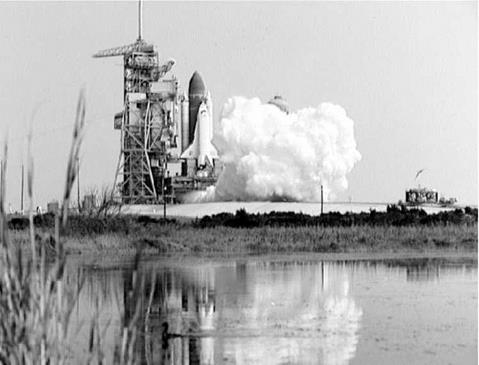

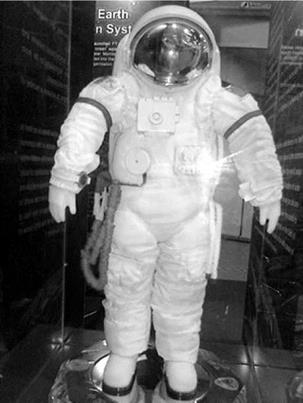
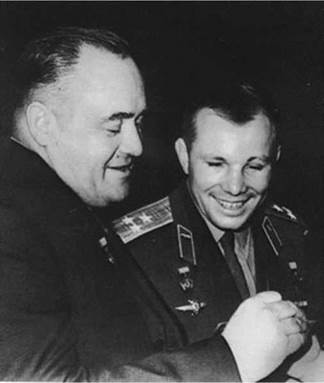
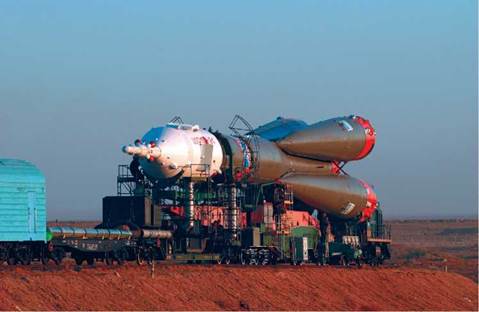
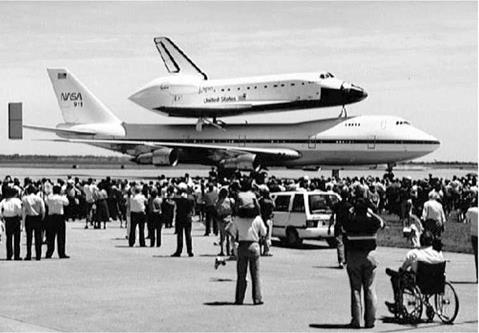
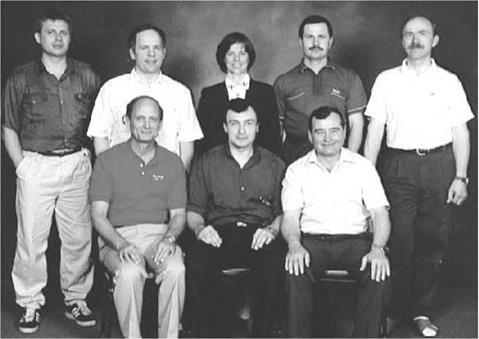
 2008-050A October 12, 2008
2008-050A October 12, 2008




